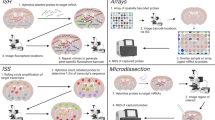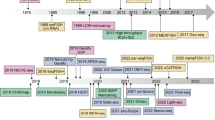Abstract
HOXA10 encodes a transcription factor required for endometrial receptivity and embryo implantation. The objective of this study was to identify and to characterize those molecular markers regulated by HOXA10 expression. The authors have identified putative HOXA10 target genes identified by microarray analysis employing a murine model of transient HOXA10 expression during the anticipated implantation window. Microarray analysis identified 40 statistically significant genes regulated by HOXA10 overexpression of which 31 genes were downregulated greater than 2-fold over control and 9 genes were upregulated. Cellular ontogenies of differentially expressed genes include cell adhesion molecules, signal transduction factors, and metabolic regulators. Semiquantitative real-time reverse transcriptase polymerase chain reaction confirmed regulation of selected candidate genes. Examples included clusterin (Clu), phoshoglycerate 3-dehydrogenase (3-Pgdh), and tumor-associated calcium signal transducer 2 (Tacstd2). Elucidation of these pathways will allow further characterization of the molecular mechanisms governing endometrial development, which also may function to enhance uterine receptivity.
Similar content being viewed by others
References
Aplin JD. The cell biological basis of human implantation. Best Pract Res Clin Obstet Gynaecol. 2000;14:757–764.
Red-Horse K, Zhou Y, Genbacev O, et al.Trophoblast differentiation during embryo implantation and formation of the maternal-fetal interface. J Clin Invest. 2004;114:744–754.
Taylor H, Vanden H, Igarashi P. A conserved HOX axis in the mouse and human reproductive system: late establishment and persistent expression of the HOXA cluster gene. Biol Reprod. 1997;57:1338–1345.
Lewis EB. A gene complex controlling segmentation in Drosophila. Nature. 1978;276:565–570.
McGinnis W, Krumlauf R. Homeobox genes and axial patterning. Cell. 1992;68:283–302.
McGinnis W, Levine M, Hafen E, Kuroiwa A, Gehring W. A homologous protein-coding sequence in Drosophila homeotic genes and its conservation in other metazoans. Cell. 1984;37: 403–408.
Krumlauf R. Hox genes in vertebrate development. Cell. 1994;78:227–256.
Block K, Kardana A, Igarashi P, Taylor HS. In utero diethylstilbestrol (DES) exposure alters HOX gene expression in the developing mullerian system. FASEB J. 2000;14:1101–1108.
Taylor HS, Igarashi P, Olive D, Arici A. Sex steroids mediate HOXA11 expression in the human peri-implantation endometrium. J Clin Endocrinol Metab. 1999;84:1129–1135.
Taylor HS, Arici A, Olive D, Igarashi P. HOXA10 is expressed in response to sex steroids at the time of implantation in the human endometrium. J Clin Invest. 1998;101:1379–1384.
Taylor HS, Vandenheuvel GB, Igarshi P. A conserved Hox axis in the mouse and human female reproductive system-late establishment and persistent adult expression of the Hoxa cluster genes. Biol Reprod. 1997;57:1338–1345.
Sarno JL, Kliman HJ, Taylor HS. HOXA10, Pbx2, and Meis1 protein expression in the human endometrium: formation of multimeric complexes on HOXA10 target genes. J Clin Endocrinol Metab. 2005;90:522–528.
Benson GV, Lim H, Paria BC, Satokata I. Dey SK, Maas RL. Mechanisms of reduced fertility in Hoxa-10 mutant mice: uterine homeosis and loss of maternal Hoxa-10 expression. Development. 1996;122:2687–2696.
Taylor HS, Bagot C, Kardana A, Olive D, Arici A. HOX gene expression is altered in the endometrium of women with endometriosis. Hum Reprod. 1999;14:1328–1331.
Satokata I, Benson G, Maas R. Sexually dimorphic sterility phenotypes in Hoxa10-deficient mice. Nature. 1995; 374:460–463.
Hsieh-Li HM, Witte DP, Weinstein M, et al. Hoxa 11 structure, extensive antisense transcription, and function in male and female fertility. Development. 1995;121:1373–1385.
Bagot CN, Troy PJ, Taylor HS. Alteration of maternal Hoxa10 expression by in vivo gene transfection affects implantation. Gene Ther. 2000;7:1378–1384.
Daftary GS, Taylor HS. Reproductive tract gene transfer. Fertil Steril. 2003;80:475–484.
Daftary GS, Taylor HS. EMX2 gene expression in the female reproductive tract and aberrant expression in the endometrium of patients with endometriosis. J Clin Endocrinol Metab. 2004;89:2390–2396.
Zhang B, Schmoyer D, Kirov S, Snoddy J. GOTree Machine (GOTM): a web-based platform for interpreting sets of inter-sting genes using Gene Ontology hierarchies. BMC Bioinformatics. 2004;5:16.
Livak K, Schmittgen T. Analysis of relative gene expression data using real-time quantitative PCR and the 2-(Delta Delta C(T)) method. Methods. 2001;25:402–408.
Aronow B, Richardson B, Handwerger S. Microarray analysis of trophoblast differentiation: gene expression reprogramming in key gene function categories. Physiol Genomics. 2001;6: 103–116.
Kao LC, Tulac S, Lobo S, et al. Global gene profiling in human endometrium during the window of implantation. Endocrinology. 2002;143:2119–2138.
Reece J, Das S, Paria B, et al. Global gene expression analysis to identify molecular markers of uterine receptivity and embryo implantation. J Biol Chem. 2001;276:44137–44145.
Lim H, Ma L, Ma WG, Maas RL, Dey SK. Hoxa-10 regulates uterine stromal cell responsiveness to progesterone during implantation and decidualization in the mouse. Mol Endocrinol. 1999;13:1005–1017.
Yao M, Lim H, Schust D, et al. Gene expression profiling reveal progesterone-mediated cell cycle and immunoregulatory roles of Hoxa-10 in the preimplantation uterus. Mol Endocrinol. 2003;17:610–627.
Daftary GS, Taylor HS. Pleiotropic effects of Hoxa10 on the functional development of peri-implantation endometrium. Mol Reprod Dev. 2004;67:8–14.
Bagot CN, Kliman HJ, Taylor HS. Maternal Hoxa10 is required for pinopod formation in the development of mouse uterine receptivity to embryo implantation. Dev Dyn. 2001; 222:538–544.
Daikoku T, Tranguch S, Friedman DB, Das SK, Smith DF, Dey SK. Proteomic analysis identifies immunophilin FK506 binding protein 4 (FKBP52) as a downstream target of Hoxa10 in the periimplantation mouse uterus. Mol Endocrinol. 2005;19:683–697.
Carson DD, Bagchi I, Dey SK, et al. Embryo implantation. Dev Biol. 2000;223:217–237.
Troy PJ, Daftary GS, Bagot CN, Taylor HS. Transcriptional repression of peri-implantation EMX2 expression in mammalian reproduction by HOXA10. Mol Cell Biol. 2003;23:1–13.
Daftary GS, Taylor HS. Endocrine regulation of HOX genes. Endocr Rev. 2004;27:331–355.
Daftary GS, Troy PJ, Bagot CN, Young SL, Taylor HS. Direct regulation of Beta3-integrin subunit gene expression by HOXA10 endometrial cells. Mol Endocrinol. 2002;16:571–579.
Cho HM, Jun DY, Bae MA, Ahn JD, Kim YH. Nucleotide sequence and differential expression of the human 3-phosphoglycerate dehydrogenase gene. Gene. 2000;245:193–201.
Yoshida K, Furuya S, Osuka S, et al.Targeted disruption of the mouse 3-phosphoglyerate dehydrogenase gene causes severe neurodevelopmental defects and results in embryonic lethality. J Biol Chem. 2004;279:3573–3577.
Al-Dhaheri MH, Shah YM, Basrur V, Pind S, Rowan BG. Identification of novel proteins induced by estradiol, 4-hydroxytamoxifen and acolbifene in T47D breast cancer cells. Steroids. 2006;71:966–978.
Mitoma J, Furuya S, Shimizu M, et al. Mouse 3-phosphoglycerate dehydrogenase gene: genomic organization, chromosomal localization, and promoter analysis. Gene. 2004;334:15–22.
Martin R, Taylor MB, Krikun G, Lockwood C, Akbas GE, Taylor HS. Differential cell-specific modulation of HOXA10 by estrogen and specificity protein 1 response elements.J Clin Endocrinol Metab. 2007;92:1920–1926.
Author information
Authors and Affiliations
Corresponding author
Additional information
This study was supported by grants NIH R01 HD038667 and U54 HD052668.
Rights and permissions
About this article
Cite this article
Vitiello, D., Pinard, R. & Taylor, H.S. Gene Expression Profiling Reveals Putative HOXA10 Downstream Targets in the Periimplantation Mouse Uterus. Reprod. Sci. 15, 529–535 (2008). https://doi.org/10.1177/1933719108316911
Published:
Issue Date:
DOI: https://doi.org/10.1177/1933719108316911




